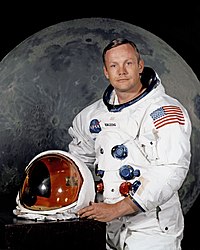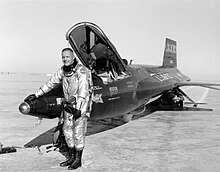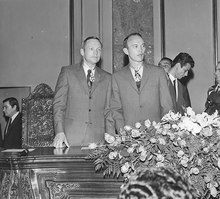Neil Armstrong
| Neil Alden Armstrong | |
|---|---|

|
|
| Neil Armstrong on July 1, 1969 | |
| Country: |
|
| Organization: |
|
| selected on | September 17, 1962 ( 2nd NASA Group ) |
| Calls: | 2 space flights |
| Start of the first space flight: |
March 16, 1966 |
| Landing of the last space flight: |
July 24, 1969 |
| Time in space: | 8d 13h 59min |
| EVA inserts: | 1 |
| EVA total duration: | 2h 31min |
| retired on | August 1971 |
| Space flights | |

Neil Alden Armstrong (born August 5, 1930 in Wapakoneta , Ohio , † August 25, 2012 in Cincinnati , Ohio) was an American test pilot and astronaut . He was in command of Apollo 11 , which flew to the moon with Buzz Aldrin and Michael Collins . On July 21, 1969, he became the first person to walk on the moon.
Life
Youth and education
Neil Armstrong came in 1930 on a farm, ten kilometers from Wapakoneta ( Ohio ) away, to the world. His father Stephen Armstrong was a state auditor, his mother Viola Engel, daughter of the German emigrant Martin August Engel, was a housewife. Friedrich Kötter, one of Armstrong's great-grandfathers, came from Ladbergen in what is now North Rhine-Westphalia . He has been fascinated by aviation since he was a boy scout with the Boy Scouts of America . He built model airplanes, got flying lessons and finally received a pilot's license on his 16th birthday, even before the car. After high school he took in 1947 with the help of a grant from the US Navy at the Purdue University study on to become an aircraft engineer. He had completed three semesters when the Navy drafted him for military service in January 1949 and sent him to Florida . In Pensacola he was trained as a fighter pilot.
Armstrong took part in the Korean War from 1950 . He was a member of Fighter Squadron 51 (VF-51) and, at the age of 20, was the youngest member of the unit stationed on the aircraft carrier USS Essex . From there he flew a total of 78 missions with his single-seat F9F “Panther” . Most of the time he did reconnaissance flights . On September 3, 1951, his plane was damaged while flying low by a rope stretched across a deep valley. Part of the wing was cut off so that a normal landing was no longer possible. Armstrong flew to Pohang airfield , which was under US control, and catapulted himself out with the ejector seat .
In the spring of 1952 Armstrong returned from his war mission to the United States and left the Navy in August of that year. He continued his studies at Purdue University and received his bachelor's degree in aeronautical engineering in January 1955 .
NASA test pilot
With this diploma, he applied as a test pilot to the National Advisory Committee for Aeronautics (NACA), the forerunner of NASA . He was hired, but could not take up the desired position. He had originally applied for the High-Speed Flight Station (HSFS) at Edwards Air Force Base . At first there was no vacancy in California, so he initially worked at the Lewis Flight Propulsion Laboratory in Ohio. When a position as a test pilot became available for him in the summer of 1955, he immediately traveled to the HSFS in Los Angeles .
At HSFS, Armstrong tested the Bell X-1 and North American X-15 missile planes (among many other types of aircraft) . His actual task was to constructively improve the tested aircraft: "Our principal responsibility was engineering work."
Ten years after Chuck Yeager broke the sound barrier for the first time with the X-1 , Armstrong flew with the "Glamorous Glennis". In November 1960 he had his maiden flight on the X-15. The highest speed he achieved on this machine was Mach 5.74 (6419 km / h) in July 1962. In addition, Armstrong was one of the pilots scheduled for the X-20 between November 1960 and his move to the space program in 1962 . He also took courses in aerospace engineering at the University of Southern California (Graduate Studies).
Armstrong was one of the nine test pilots selected by the US Air Force in June 1958 for the Man In Space Soonest (MISS) project, the first US astronaut group. However, the MISS project was canceled shortly after when NASA was founded and took over all US spaceflight activities. As a NASA test pilot at NASA Flight Research Center in Edwards, California, Armstrong flew many groundbreaking high-speed aircraft, including the X-15, which can reach over 7,000 km / h . He flew over 200 different types of aircraft, from jets to rocket planes and helicopters to gliders.
NASA astronaut
For the first group of astronauts ( Mercury Seven ), which was selected by NASA, Armstrong was out of the question, as he was already a civilian again at this point and only military personnel could be selected for this group.
In the second group of astronauts, however, he came to the train and was presented to the public on September 17, 1962 with eight other future space travelers. In his first time as an astronaut, he took over simulators as a specialty for the Gemini program .
Use in the Gemini program
In February 1965, Armstrong was named commander of the Gemini 5 mission, replacing Gordon Cooper . He was not used, but served as a liaison speaker ( Capcom ). Upon completion of this flight, he was nominated as commander of flight Gemini 8 , which began on March 16, 1966. Armstrong was thus one of the few astronauts to whom NASA gave command during the first space flight. During this mission he and his pilot David Scott paired two spacecraft in space for the first time, but Gemini 8 staggered badly. The astronauts brought the situation under control, but the mission was cut short. This was the first time that a space flight was prematurely terminated.
After landing, Armstrong was assigned as the replacement commander for Gemini 11 in September 1966. On the Gemini 9 mission in June 1966, Armstrong again served as Capcom.
Team allocation in the Apollo program
Because Armstrong was involved in the Gemini program for a relatively long time, he was not one of the six commanders nominated for the first Apollo flights . Only after the Apollo 1 disaster and the death of Gus Grissom in January 1967 did he move up and in November 1967 he was nominated as the replacement commander of the third manned Apollo flight. This gave him a good chance of being in command of the sixth flight. Because it was not clear at the time how many Apollo test flights would be necessary, it was not yet clear whether this would be a flight with a moon landing. The first moon landing was planned for the fifth manned mission at the earliest.
Delays in the development of the lunar module led to a rescheduling of the Apollo flights in the summer of 1968: the third manned test flight (Mission E) was canceled, instead a moon flight without a lunar module was inserted between the first and second test flight (Missions C and D), the one below called Apollo 8 was carried out. Armstrong thus became the substitute commander for the first manned flight to the moon. As usual, the reserve crew was assigned as the main crew for the third flight, Apollo 11 . If the next two flights, Apollo 9 and Apollo 10 , were successful , this would be the first attempt at a manned moon landing.
Armstrong's nomination as the first person to set foot on the lunar surface was by no means well prepared. As he himself said in an interview in 1966: Who this person is is decided by a kind of happy circumstance (“who the person is is sort of happenstance”). The rescheduling of Apollo 8, the success of Apollo 9 and Apollo 10 and also the death of Grissom had played a role.
The moon landing
During training for the moon landing, Armstrong narrowly escaped death on May 6, 1968 in the crash of a lunar landing training vehicle ( Lunar Landing Training Vehicle ). During the moon landing with his colleague Buzz Aldrin on July 20, 1969, he took over manual control of the lunar module Eagle and steered it away from rocky terrain to a safe landing at 8:17 p.m. ( UTC ). His first words from the moon to the ground station were "Out of DETENT". Shortly afterwards, with the famous words “Houston, Tranquility Base here. The Eagle has landed "known the landing. Six hours later, in the early morning hours of July 21, he climbed out of the lunar module. Neil Armstrong became the first person to walk on the lunar surface on July 21, 1969 at 2:56:20 a.m. (UTC). This created one of the most famous slip of the tongue in history: Armstrong had resolved to use the words That's one small step for a man, one giant leap for mankind (Eng. "This is a small step for a person, a giant leap for mankind") to speak, but failed to pronounce a single vowel ( a ) due to the stress and excitement and thus gave the sentence an unwanted meaning:
“That's one small step for man… one… giant leap for mankind. ( ) ”
"This is a small step for man ... a ... giant leap for mankind."
Armstrong only admitted his slip of the tongue for the first time during an interview for the book Chariots for Apollo (1986) - after many years of diverse reports, evidence and alleged counter-evidence. The tremendous scientific and cultural significance of the first moon landing, however, dwarfed its slip of the tongue, and while it did not accurately reproduce the lines provided, it was some of the most famous words ever spoken in the world.
Allegedly, before returning to the lunar module, Armstrong said the phrase Good Luck, Mr. Gorsky . Armstrong himself denied this modern legend back in 1995.
Armstrong received the Presidential Medal of Freedom for his achievement in 1969 .
Life after Apollo

In 1970 Armstrong was promoted to assistant director of NASA's Washington aeronautical office. In the same year he also received a Masters in Aerospace Engineering from the University of Southern California and an Honorary Doctorate in Engineering from Purdue University. In 1971 he left the agency. After leaving NASA, he taught from 1971 to 1979 as a professor of aerospace engineering at the University of Cincinnati . He then switched to business, where he held supervisory board and management positions. He became a millionaire by founding his own company. From 1985 to 1986 Armstrong served on the National Space Commission and in 1986 was appointed vice chairman of the Challenger Disaster Investigation Commission. In 1989 he joined the board of directors at Thiokol, the manufacturer of the space shuttle's solid fuel boosters .
Armstrong was a strong proponent of a manned Mars mission. In 2004, he called on the Americans to support and support US President George W. Bush for future NASA moon and Mars missions .
In 2010 he criticized President Barack Obama's decision not to send people to the moon any more. In an open letter to Obama that he was instrumental in initiating, the undersigned express themselves "very worried" that the USA is "ceding its hard-won global leadership in space technology to other nations".
Private
Armstrong married his student lover, Janet Shearon, in January 1956. The couple had two sons and a daughter who died at the age of two. Janet and Neil Armstrong divorced in 1994 after a long separation. In the same year he married Carol Held Knight for the second time. With her he lived in seclusion near Cincinnati .
On August 7, 2012, four stenoses were found in Armstrong's coronary arteries that required immediate bypass surgery . Neil Armstrong died on August 25, 2012 as a result of the surgery.
On September 15, 2012, Armstrong's ashes from the deck of the cruiser USS Philippine Sea were turned over to the sea in the Atlantic .
In July 2019, the New York Times published that Neil Armstrong's relatives had received $ 6 million from the hospital in compensation for medical errors after surgery.
Special features and records
- First pairing with another spacecraft ( Gemini 8 )
- First emergency landing of a spaceship (Gemini 8)
- First man on the moon ( Apollo 11 )
Awards
- 1969: Medal of Freedom ( "The Presidential Medal of Freedom"), the highest civilian award of the United States.
- 1969: Imperial Cultural Order of Japan.
- 1978: Armstrong was one of the first six astronauts to be awarded the Congressional Space Medal of Honor on October 1, 1978 .
- 1979: National Aviation Hall of Fame as third spaceman.
- 2001: Elected Member of the American Philosophical Society .
- 2005: Honorary Doctorate from the University of Southern California.
In September 2012 the US Navy named the research vessel USNS Neil Armstrong (T-AGOR-27) after him.
The Dryden Flight Research Center was renamed the Neil A. Armstrong Flight Research Center in his honor in January 2014 .
The lunar crater Armstrong and the asteroid (6469) Armstrong are named after him.
filming
In 2018 the historical film Aufbruch zum Mond , directed by Damien Chazelle , was released, in which Armstrong is portrayed by Ryan Gosling . The film focuses in particular on the long lead time for the moon mission.
See also
literature
- Jay Barbree: Neil Armstrong - A Life of Flight. Thomas Dunne, New York 2015, ISBN 978-1-250-04071-8 (English).
- James R. Hansen: First Man - The Life of Neil A. Armstrong. Simon & Schuster, New York 2018, ISBN 978-1-9821-1047-5 (American original edition).
- James R. Hansen: Departure to the Moon . Neil Armstrong - The Authorized Biography. Wilhelm Heyne, Munich 2018, ISBN 978-3-453-60463-6 (German first edition with 95 historical black and white photos).
Web links
- Literature by and about Neil Armstrong in the catalog of the German National Library
- Neil Armstrong biography . In: NASA website
- Neil Armstrong biography . In: Who's Who.de
- Neil Armstrong in the Encyclopedia Astronautica (English)
- Neil Armstrong in the Internet Movie Database (English)
- Transcript of the Apollo 11 mission . In: NASA website
obituary
- US astronaut Neil Armstrong is dead - a humble hero . In: Morgenpost.de , August 26, 2012
- Hellmuth Vensky: Neil Armstrong is the real man who dies in the moon . In: Zeit Online , August 26, 2012
- Frank Junghänel: Neil Armstrong - In the Sea of Silence . In: Fr.de , August 26, 2012
- Neil Armstrong - The silent hero of space travel . In: Augsburger-Allgemeine.de , August 26, 2012
Individual evidence
- ↑ James R. Hansen: First Man ... p. 589 (2012 edition)
- ↑ Hansen, Aufbruch zum Mond, p. 107
- ↑ ... Ladbergen, the birthplace of Neil Armstrong's great-grandfather
- ↑ Koestler Grack, Rachel A .: Neil Armstrong . Pleasantville, New York, ISBN 978-1-4339-2147-6 .
- ↑ James R. Hansen: First Man ... p. 138 (2012 edition)
- ^ NASA: Biography of Neil Armstrong
- ↑ Apollo 11 transcript. In: Spacelog. Retrieved January 14, 2019 .
- ^ The Guardian April 15, 2010: Obama's devastating Nasa cuts. - Open letter: Neil Armstrong, James Lovell and Eugene Cernan urge Obama not to forfeit US progress in space exploration
- ↑ a b Neil Armstrong, First Man on Moon, Dies at 82 , The New York Times , Aug 25, 2012 (pp. 1-3).
- ↑ James R. Hansen: First Man ... p. 644 (2012 edition)
- ↑ christianpost.com August 8, 2012: Neil Armstrong Bypass Heart Surgery Successful After 4 Blockages Found on Coronary Arteries
- ↑ plus.google.com: A statement from the NASA Administrator regarding Neil Armstrong's recovery from cardiac bypass surgery
- ↑ US astronaut Neil Armstrong is dead. Spiegel Online , August 25, 2012, accessed on August 25, 2012 .
- ↑ Scott Shane and Sarah Kliff: Neil Armstrong's Death, and a Stormy, Secret $ 6 Million Settlement. The New York Times , July 23, 2019, accessed July 25, 2019 .
- ^ Member History: Neil Armstrong. American Philosophical Society, accessed April 12, 2018 (with a short biography).
- ↑ US Navy: Navy Announces Research Vessel To Be Named In Honor Of Neil Armstrong
- ↑ Notes on Going to the Moon - Neil Armstrong. The authorized biography (PDF). In: RandomHouse.de. Retrieved July 18, 2019.
| personal data | |
|---|---|
| SURNAME | Armstrong, Neil |
| ALTERNATIVE NAMES | Armstrong, Neil Alden (full name) |
| BRIEF DESCRIPTION | American astronaut, first man on the moon |
| DATE OF BIRTH | 5th August 1930 |
| PLACE OF BIRTH | Wapakoneta , Ohio, USA |
| DATE OF DEATH | August 25, 2012 |
| Place of death | Cincinnati , Ohio, USA |





